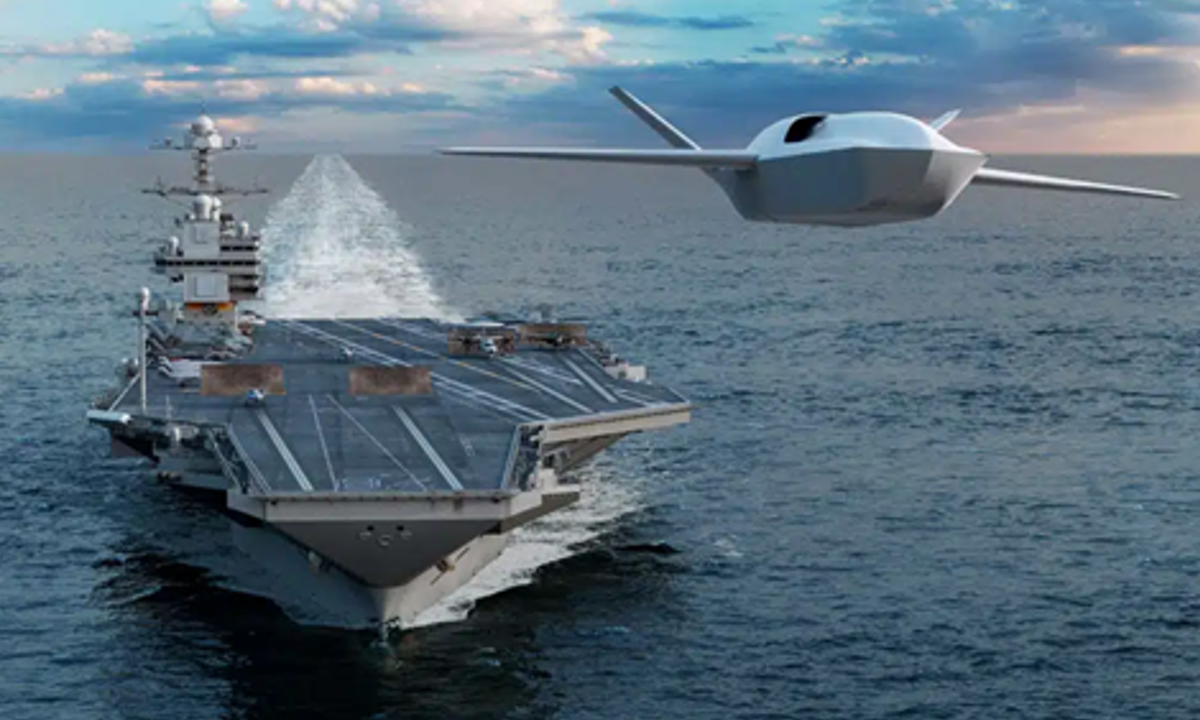By Guo Yuandan and Liu Xuanzun

A computer-generated illustration shows a Collaborative Combat Aircraft launches from a US Ford-class aircraft carrier. Photo: Screenshot from Naval News
US company General Atomics Aeronautical Systems, Inc. (GA-ASI) has been contracted by the US Navy to develop conceptual designs for a collaborative combat aircraft (CCA) to support the US carrier air wing of tomorrow, Naval News reported on Sunday. A Chinese military affairs expert told the Global Times on Sunday that manned-unmanned teaming is a growing trend, noting that with China recently debuting loyal wingman drones and air superiority drones, China and the US are leaders in this field, which could significantly change the shape of warfare.
Citing a CA-ASI press release, the Naval News report said that GA-ASI was selected to work on US Navy CCA designs emphasizing a modular approach to platform selection, capable of being rapidly reconfigured and upgraded to meet changing mission requirements, including operations on and from aircraft carriers. GA-ASI's approach supports the US Navy's revolutionary acquisition strategy of smaller, frequent purchases that enable rapid technology insertion rather than traditional long-lifecycle programs, the press release claimed.
CCA is a term used by the US Air Force to describe what was often called loyal wingman drones, and now the US Navy is also ramping up developing CCAs.
CCAs are highly capable, semi-autonomous jet fighters that complement and enhance traditional, human-piloted combat aircraft. Produced in high quantities at comparatively low cost, they let commanders shift risk away from human flight crews, enhance the sensing and other capabilities of legacy aircraft formations, increase lethality of the air wing, and maximize operational flexibility across the board, according to the Naval News report.
The US Navy's CCA design will emphasize seamless coordination among manned fighters, uncrewed vehicles and support platforms; accommodate elevated risk profiles and reduce risk to crewed platforms; support and enhance 4th- and 5th-generation aircraft and complement 6th-generation aircraft; and maximize operational flexibility, cost efficiency and mission effectiveness, the report claimed.
Chinese military affairs expert Zhang Junshe told the Global Times on Sunday that the US Navy has been advancing the collaborative combat model of manned-unmanned teaming aircraft, in which the development of the CCA is a key component.
On one hand, unmanned combat aircraft can serve as aerial arsenals, carrying large quantities of ammunition to strike ground or maritime targets; on the other hand, the use of unmanned combat aircraft can reduce casualties, as they can be deployed in combat over sea and air domains with dense air defense firepower without the need to consider human losses, which is the greatest advantage of unmanned combat systems, whether in ground, air, or maritime warfare, Zhang said.
GA-ASI's Navy CCA contract follows its selection to design and fly the US Air Force's first CCA, the YFQ-42A. A production-representative unmanned fighter, YFQ-42A, was the first US Air Force CCA to begin flight testing in August, Naval News reported.
Song Zhongping, another Chinese military affairs expert, told the Global Times that the US Navy's decision to partner with GA-ASI could have been largely influenced by the company's existing foundation in developing CCA for the US Air Force.
"It has been a normal practice to adapt air force aircraft designs to develop naval aircraft, although necessary adaptations must be made, Song said.
Zhang said that developing a naval aircraft from an air force version is an international development trend. This approach not only saves development costs, reduces development time by utilizing mature aircraft models to develop another military variant, due to similar performance and design philosophies, it can also more effectively enhance joint combat capabilities between the air force and navy.
China is also utilizing this concept, with the Chinese People's Liberation Army (PLA) Air Forces' J-35A fighter jet and the PLA Navy's J-35 carrier-borne fighter jet, Zhang noted.
The US is not the only country that has been developing CCAs.
During China's V-Day military parade in Beijing on September 3, the PLA unveiled two previously unseen uncrewed combat aerial vehicles (UCAVs) and two CCAs, "highlighting China's continuing investment in uncrewed systems, US media outlet Aviation Week reported at the time.
According to official descriptions provided at the military parade, these aircraft are loyal wingman drones and air superiority drones.
An expert told the Global Times at the time that the air superiority drones can be seen as one of the most cutting-edge weapons and equipment in the entire aerial unmanned combat formations. This type of drone has strong independent aerial combat capabilities. From a global perspective, this type of unmanned equipment is leading and pioneering, capable of overturning the existing air combat scenarios and profoundly change future air combat mode.
Zhang said that manned-unmanned teaming is both a concept and a future development trend, as major military powers are all striving to compete in this domain, with the US and China both in leading positions.
"To a certain extent, manned-unmanned teaming operations are gradually transitioning from concept to reality and will significantly impact the form of future warfare," Zhang said.



